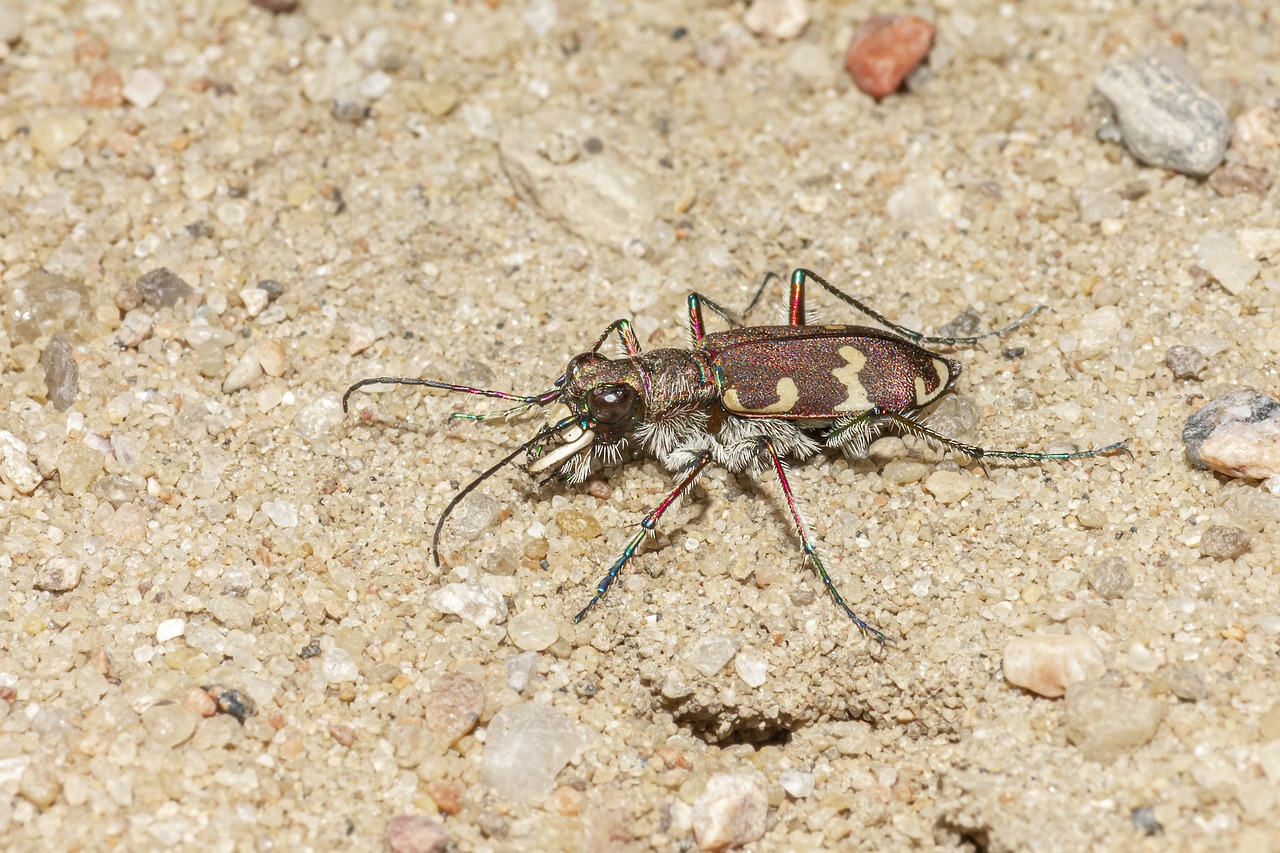The Northern Dune Tiger Beetle (Cicindela hybrida) is a striking and agile beetle species known for its speed and hunting prowess. Here’s a brief overview of this fascinating insect:
Description
- Appearance: The Northern Dune Tiger Beetle is a medium-sized beetle, measuring between 12 to 15 mm in length. It has a metallic sheen with a predominantly bronze-green to dark brown body. The elytra (wing covers) are marked with a characteristic pattern of cream or white spots and wavy lines. The beetle’s large, protruding eyes and long, slender legs are well-adapted for its active predatory lifestyle.
- Color Variations: Depending on environmental factors, the coloration of this beetle may range from reddish-brown to greenish. The species is named “hybrida” because it shows a lot of variation in its markings and color.
Distribution and Habitat
- Geographical Range: The Northern Dune Tiger Beetle is found across much of Europe, including parts of Scandinavia, the Baltic states, Central Europe, and down to the Mediterranean region. It is also present in parts of Asia, extending east to Siberia.
- Preferred Habitats: This beetle prefers open, sandy areas with sparse vegetation, such as dunes, riverbanks, gravel pits, and sandy heaths. It thrives in environments where the soil is loose and exposed to the sun, which helps with thermoregulation and hunting.
Behavior and Ecology
- Active Hunter: As a member of the tiger beetle family, it is an active predator. The beetle is known for its exceptional speed and agility, capable of running rapidly to chase down prey or avoid danger. It primarily hunts small insects and other arthropods, using its powerful mandibles to catch and consume them.
- Hunting Strategy: The beetle uses its excellent vision to spot prey from a distance, sprinting towards it and capturing it with a swift bite. It often pauses during these sprints to reorient itself, as its eyes are more adapted to detecting motion than fine detail.
- Diurnal Activity: The Northern Dune Tiger Beetle is mostly active during the day, especially in sunny conditions. During colder or rainy days, it may be less active and seek shelter.
Life Cycle
- Reproduction: Mating usually occurs in spring or early summer. After mating, females lay their eggs in small burrows in sandy soil. The larvae hatch and dig their own burrows, from which they ambush passing prey.
- Larvae: The larvae are also predatory and are equipped with powerful jaws. They have a distinctive shape with a large head and a slightly humped body. They create vertical burrows in sandy soil and wait at the entrance, capturing passing prey by leaping out and dragging it back into their burrow.
- Pupation: The larval stage lasts for about one to two years, after which the larvae pupate in their burrows. The pupation period varies depending on environmental conditions.
Interesting Facts
- Speed: The Northern Dune Tiger Beetle is one of the fastest running insects in the world. It can move at a speed of up to 9 km/h (about 5.6 mph), which is impressive considering its small size.
- Adaptability: This species has developed a tolerance for a range of temperatures, but it requires sandy habitats with ample sunlight. The beetle’s color can sometimes blend with the sand, providing it with some level of camouflage.
- Thermoregulation: The beetle relies on its ability to regulate its body temperature through behavior. It may be seen basking in the sun to warm up or retreating to shaded areas or burrows to cool down.
Conservation Status
- Population: The Northern Dune Tiger Beetle is generally not considered endangered, but its populations can be affected by habitat loss due to human activities such as development, sand extraction, and changes in land use.
- Conservation Efforts: Efforts to conserve this species focus on protecting and maintaining its natural habitats, such as sandy dunes and riverbanks. Conservationists may work to preserve or restore these areas, ensuring that they remain open and exposed to sunlight, which is vital for the beetle’s life cycle.
The Northern Dune Tiger Beetle (Cicindela hybrida) is a remarkable insect, admired for its speed, predatory efficiency, and adaptability to challenging environments. Its presence in sandy habitats across Europe and Asia makes it a fascinating subject for entomologists and nature enthusiasts alike.
Visited 103 times, 12 visit(s) today
Views: 161
Subscribe to the newsletter:
